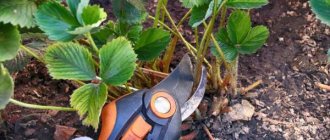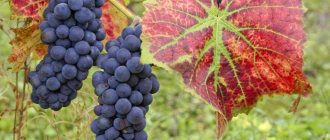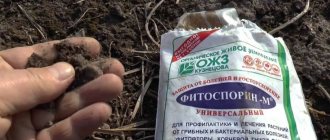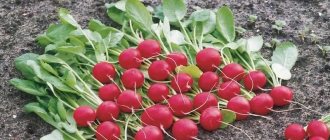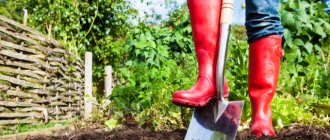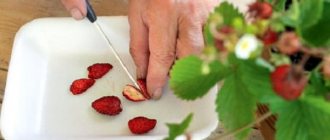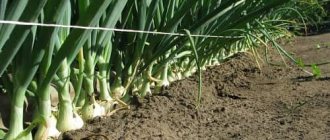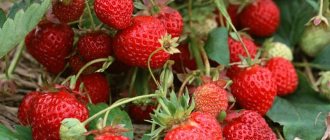Strawberries are actually large-fruited garden strawberries. It is grown on an industrial scale and in private farmsteads, because it is one of the earliest berries to grace our table. The weight of one berry can reach up to 75 g, and in some varieties up to 100 g. Summer residents have a lot of questions about the autumn care of this crop. The viability of plants and their ability to produce crops in the next season depend on how well the preparation for winter is carried out.
In what cases are strawberries covered for the winter?
Many regions of Russia are characterized by cold winters and sometimes prolonged autumn frosts. To help strawberries overwinter without problems, you need to prepare the bushes in advance for low winter temperatures.
To decide whether the strawberries on your site need shelter for the winter, you need to know whether the variety of your crop is frost-resistant or not.
Also analyze how the winter progresses in your area: how low the temperature drops during the winter season and how much snow usually falls.
If the winters are mild (up to -10°C) and snowy (cover of at least 25-30 cm), then strawberries will overwinter without problems and will not freeze. Otherwise, when the winters are cold or with little snow, and the variety itself is not a winter-hardy variety, it is necessary to start covering the strawberry bushes in time in the fall.
Covering time for strawberries
In order to insulate strawberries in a timely manner, it is first important to understand the meaning of the temperature regime for them. Then the gardener will be able to draw the right conclusions about the full development of the crop, existing threats and critical temperatures.
Important! It is strictly forbidden to close plants ahead of schedule, since in such conditions they will be subject to intense evaporation of moisture and heat, as a result of which they will bloom or trample. In the first case, actively vegetating specimens will die at the beginning of the cold snap, and in the second, part of the berry garden will also have to be culled, planting new bushes in the rows.
The main feature of garden strawberries and strawberries is that their root zone is located at a depth of 6–8 cm. These soil layers freeze even with slight frost. If the above-ground part of the bush can withstand such conditions, then during a period of sharp temperature changes, the bush dies.
It is impossible to unequivocally answer the question at what temperature it is worth starting to build a shelter in a strawberry bed. After all, the winter-hardy qualities of varietal plants play a significant role. For example, for some, a temperature of -4ºС may be critical, while others will survive -8ºС. In addition, it is worth considering that strong gusts of wind reduce the temperature in the area.
Experts advise beginning gardeners to start covering their strawberry plots at the first frost. It is important to focus on the monthly forecasts of weather forecasters, since the coming warming after the temperature drops to sub-zero may destroy strawberries.
At what temperature are strawberries covered for the winter?
Not any time in the fall is suitable for starting to cover strawberries for the winter: if you do it too early, the bushes will begin to rot, and if it’s too late, they will freeze. It is recommended to cover strawberries after the autumn rainy season has passed, before the onset of stable cold weather (-8 -10°C).
It is better to carry out all the necessary sheltering procedures (clearing the soil of weeds, cutting off diseased leaves, preparing material for winter shelter and covering the bushes itself) in the fall, when frosts have already begun at night, and during the day it will still remain above zero.
Thus, you need to start covering strawberries for the winter if:
- over the last few days (week), the thermometer has dropped daily to - 5-8oC;
- the frozen layer of earth reaches a depth of 5 cm: this can be found out from reports from meteorological services or using a metal hollow cylinder of water placed in the ground in advance (use a ruler to determine the depth of freezing of water).
REFERENCE! Winter shelter for strawberries not only saves the bushes from freezing. In winter, thaws are possible, after which frosts set in again, which will lead to a decline in the plant’s strength or even its death.
Shelter materials
To cover strawberries, you can choose any materials that suit the climate and the owner’s desires. There are inorganic and organic covering materials.
Inorganic materials
Agrofibre
This type includes a special coating, including spunbond. Agrofibre provides protection from frost, the possibility of early planting, protection from weeds, and the creation of an air gap. You can choose medium or light fabric, as well as color - black or white.
Polyethylene
This material does not allow moisture to pass through, but the sun reaches the plant and retains heat. The downside may be overheating of the plants, therefore, it is necessary to leave a hole for ventilation.
When to cover strawberries in different regions
For strawberries, the optimal time for the formation of a winter shelter will be days when the temperature at night is consistently negative, and during the day it is still above zero. The dates when you need to start covering strawberries for the winter in the fall will be different not only in different parts of the country, but also in the same area over the course of many years, since the climate can change.
Siberia
Siberia in winter is characterized by a temperature minimum reaching -30 – 45°C.
In Siberian cities, winters are full of snow, but some strawberries can still freeze at such low temperatures, even under deep snow cover. As practice shows, frosts can occur as early as September, so by October you need to finish covering the strawberries, choosing the appropriate day of the lunar calendar for the procedure.
Amur Region and Khabarovsk Territory
These areas are also characterized by very cold winters. In addition to early frosts in the fall (mid-late September), strong gusts of wind in November become a dangerous factor for strawberries.
Therefore, in the fall, you need to start covering strawberries for the winter in these regions in mid-October; you should pay special attention to choosing a favorable day according to the lunar calendar and firmly fixing the insulating materials.
Transbaikalia
Transbaikalia is characterized by frequent gusty winds, little snow and severe winters (temperatures can drop to -50°C), as well as frequent temperature fluctuations (the amplitude can reach 20°C even within one day).
Summer residents in this region do not even neglect storing bushes in winter in a room with a temperature of +3-5°C.
The process of covering strawberries begins with the onset of frost in early December and ends towards the end of the first month of winter.
Moscow region
In winter, thermometers in the Moscow region can show -25 – 30°C. Therefore, a cover of snow 30 cm deep is a completely reliable insulation for strawberries. It would be optimal to start covering the bushes in late October - early November, checking the lunar calendar.
Leningrad region
Here, most likely, winter will not pass without temperature fluctuations and thaws in the first half of winter. Gardeners in the Leningrad region cannot rely on snow cover to cover their strawberries. By mid-October according to the lunar calendar, preparations for the materials necessary for the winter shelter are completed in order to complete the insulation work by the beginning of November.
When to cover strawberries in 2022 according to the lunar calendar, favorable and unfavorable dates
The Moon, a satellite of the Earth, can have a powerful influence on the life cycles of living organisms on our planet. We know that there are several lunar phases: new moon, waxing phase, full moon and waning phase.
Passing through these phases, the Moon always affects the state of the Earth's flora and fauna in different ways. Among gardeners and summer residents there are many who deny the lunar influence on the condition of plants on the site, but there are even more who, on the contrary, do not doubt it at all.
If you prefer to rely on the Earth’s satellite in gardening matters, then here are some tips on which day according to the lunar calendar you need to insulate strawberries, and on which day of the lunar calendar it is better not to do anything.
If we talk in general about the lunar phases, experienced gardeners recommend adhering to the following rules:
- On the new moon according to the lunar calendar, try once again not to disturb the crops being grown, instead pay attention to pests and insects that you would like to get rid of;
- On a full moon according to the lunar calendar, it is also better not to work with plants; concentrate on procedures with fruits and berries;
- During the growing phase according to the lunar calendar, nutrients move from the roots to the foliage, that is, it is best to work with the soil, water it and fertilize it;
- In the waning phase according to the lunar calendar, plant juices, on the contrary, rush from the leaves to the roots, so you can trim leaves, get rid of weeds, and also plant root crops.
Returning to when are the most favorable days according to the lunar calendar for covering strawberries for the winter, it is worth noting that there are quite a lot of them!
But do not forget that you need to determine in advance, based on the climatic conditions of the region, when you need to start insulation work.
In 2022, according to the lunar calendar, the following days are considered favorable for covering strawberries in the fall for the winter:
- According to the lunar calendar for October: 13-18 (corresponds to the 7-13 day of the waning phase, the constellations Capricorn, Aquarius, Pisces), 25-31 (19-25 day of the waning phase, the constellations Gemini, Cancer, Leo and Virgo);
- According to the lunar calendar for November: 1-2 (25-27 day of the waning phase, constellations Virgo, Libra, 11-13 (7-10 day of the growing phase, constellations Aquarius, Pisces), 23-26 (19-23 day of the waning Moon, Moon in Cancer, Leo)
- According to the lunar calendar for December: 1 (26-27 day of the waning phase, constellation Libra, 11-13 (7-10 day of the waxing Moon in Pisces, Aries), 23-26 (19-22 day of the waning Moon in Leo, Virgo), 30-31 (25-27 day of the waning phase in the constellations in Scorpio, Taurus).
INTERESTING! The days in November, when according to the lunar calendar in 2022 it is best to cover strawberries in the fall for the winter, completely coincide with days favorable for harvesting the site. Therefore, if there are unfinished cleaning tasks left, be sure to finish them.
How to prepare strawberries for shelter for the winter, what to do before sheltering
Preparing strawberries for shelter for the winter is the most important stage of autumn work to preserve the health of the plant.
At the end of August, it is necessary to weed the bushes so that the soil and root system have time to restore nutrients before the onset of frost.
In addition to weeds, it is worth getting rid of excess tendrils on strawberries and dried or damaged leaves so that they do not deprive the main shoots of nutrition. Keep only the mustaches you want to use next spring.
Immediately after weeding, start fertilizing with phosphorus-potassium fertilizers. In September, it will be optimal to fertilize with organic fertilizers (humus or manure): it is necessary to distribute the fertilizing on the soil throughout the area.
The final stage of preparing strawberries for winter shelter in the fall will be treating the bushes against pests: use wood ash and metaldehyde for clear mites and slugs, and copper preparations for gray rot.
A week before the formation of the winter shelter, be sure to carry out pre-winter watering (regardless of autumn precipitation, watering should be plentiful) and loosen the soil between the rows.
Do I need to trim strawberry leaves in the fall?
Many gardeners question the need to prune strawberries in the fall. Adherents of pruning are sure that insect pests, pathogens of fungal and viral infections multiply on old peduncles and leaves.
Therefore, timely removal of most of the foliage contributes to the health of plants. Opponents of pruning believe that a pruned bush will devote all its efforts to restoring green mass, as a result of which it will go into winter weakened.
To avoid this, pruning can be done immediately after fruiting has ended. Then the plant will have time to form new greenery before the onset of cold weather.
If you plan to form bushes in the fall, then you only need to remove damaged, diseased and dry leaves. Lush foliage protects the bush from winds and frost, so you should not leave it bare in winter.
Remontant varieties are not pruned in the fall, only diseased and damaged leaves are removed.
How to cover strawberries for the winter in different ways
As mentioned earlier, if your region gets a lot of snow in the winter, then you are very lucky! Snow cover is the best natural insulation for strawberries for the winter.
Simply collect snow from the area and distribute it over the strawberry plantings. To avoid snow being weathered by strong gusts, make fences (boards and boards 10 cm above the planting level).
If winter is characterized by temperature fluctuations, during which partial melting of the snow is possible, then this option for covering strawberries will not suit you. Let's consider other options for covering materials for strawberries for the winter.
Dry leaves
A nearby deciduous forest, park or shelterbelt allows gardeners to use fallen leaves as winter shelter.
Leaves of oak, chestnut, poplar are best suited for this, and worse - walnut. The foliage must be collected in advance, thoroughly dried and packed in bags until the moment is suitable for winter shelter.
Don’t forget to check if there are any diseases or pests on the leaves that can easily infect strawberries. The foliage of fruit trees (for example, apple, pear, bird cherry, rowan, and so on) can be infected with fungal spores and bacteria, therefore, it is better not to use it to cover strawberries.
Using tree foliage as insulation for the winter is not suitable for areas with temperature changes and high humidity, as strawberries may be prohibited.
Needles and spruce branches
The problems of using foliage as a winter covering material are easily solved by using pine needles and spruce branches. This biomaterial perfectly protects against frost and allows air to pass through quite well, preventing the growth of bacteria and fungi, as well as the appearance of mold.
If luck is on your side and there is a coniferous forest nearby, then collect the required amount of pine needles or spruce branches and lay them on the strawberries in a layer of 20-30 cm. If there is already the first snow on the beds, simply lay the pine needles and spruce branches on top of it. If you are afraid that the shelter will be blown away by the wind, just lay a few boards on top of the branches.
IMPORTANT! The smell of pine needles repels rodents, so they will avoid strawberry plantings insulated with pine needles.
White mustard and oats
In August, white mustard and oats can be sown between the rows. Then in winter, when the crops grow, you will have an excellent covering material for strawberries that is not inferior in characteristics to agrofibre. In addition to providing winter cover, oats and mustard will help retain snow so you don't have to fence them in additionally.
Also, if desired, the oats and mustard can be mowed and simply laid in a layer on the strawberries for cover.
Wood sawdust
Wood chips can be found in sawmills and used as winter shelter. It is enough to spread the sawdust in a dense layer and not worry about it scattering around the area, as it will simply get wet.
For 1m2 you need a bucket of sawdust. However, in the spring, the layer of sawdust must be removed at the first warming in order to avoid acidification of the soil.
Rags
If you have plenty of old rags, then they can also act as a winter shelter for strawberries for the winter. Before covering the beds with rags, it is necessary to treat it with a 7% solution of Bordeaux mixture to prevent the spread of diseases on the berries. It is necessary to lay the rags as tightly as possible, without leaving empty open areas.
Reed
Mown reeds can easily protect strawberries from winter cold. It is enough to lay it in layers several centimeters thick to insulate the bushes. The reeds will not scatter under gusts of wind, and in the spring they will not cause problems in cleaning.
Hay
Hay is really good as insulation, but it often harbors rodents, which is dangerous for plants. In addition, hay can easily be scattered across the site by the wind. Therefore, it is more effective to use hay together with spruce branches: lay layers of hay on the bed (up to 20 cm), and on top there is a layer of spruce branches. This will repel rodents and allow the hay to remain in place throughout the winter season.
Agrofibre
Agrofibre is a high-density non-woven material. It ideally protects plants from low temperatures. To use agrofibre, you must first build special fences around the beds to secure the insulation. The fence should be 12-17 cm above the soil.
Next, lay agrofibre in 1-2 layers (7 cm high), and then fix it on the fence. To stretch the fabric taut and secure it to the bed, attach rings on both sides of the bed and fiber and string the twine through.
The edges of the agrofibre on the outside need to be secured with heavy boards, bricks or stones (it is better to wrap the weighting material once with cloth and add a twist).
Covering material "Agrotex"
“Agrotex” does not require the use of special covering methods; like any other insulation, it just needs to be pulled over the bed and fixed. A huge advantage of Agrotex is that it prevents rodents from settling near strawberry plantings!
Also, the bushes retain access to water and light, and dangerous temperature changes are smoothed out. This insulation can be easily found in specialized stores or simply ordered in an online store.
Film and spunbond
If you decide to use film or spunbond, keep in mind that this type of material can lead to freezing of bushes and soil in places of contact with the covering sheet.
For effective coverage and the desired result, spunbond and film must be pulled over arcs (plastic or metal). Install the required number of arcs over the beds in advance (2-3 arcs per bed, focusing on its length) and stretch the film or spunbond on top.
You can also fix it with any available weights (logs, stones, bricks, etc.).
Most likely, at first many doubts may arise: should you even cover your strawberries for the winter, what material to choose, and when to start preparing. Over time, you will find exact answers to all these questions; advice from neighbors, Internet resources and literature will also help you with this.
In addition, you can always experiment: you can use different winter shelters in different beds, or you can leave one bed uncovered altogether.
Thus, in the spring, by comparing the condition of overwintered bushes, you can understand whether strawberries need shelter for the winter and what preserves the bushes better.
Features of sheltering strawberries planted in different places
Strawberries are not always grown in garden beds. Sometimes gardeners decide to plant bushes in a prepared pipe (both vertically and horizontally), in car tires, boxes, etc. How to cover strawberries planted in different places?
Covering strawberries planted in a pipe
If strawberries are planted in pipes on your site, they should first be placed in pre-dug trenches. The pipe should be located half its height in the ground (if possible, it is better to move the pipes to greenhouses for the winter).
After you have placed the pipe in the trench and sprinkled it with earth, you need to cover the strawberries with any suitable covering (agrofibre, spunbond, film, etc.) and secure it at the edges with weights.
Covering strawberries planted in tires or boxes.
If possible, it is also recommended to move tires and boxes with strawberries to greenhouses.
Regardless of whether the strawberries will winter outside or in a greenhouse, it is necessary to use covering material to protect them from low temperatures and wind. Just cover the “flowerbed” with any insulation and firmly fix it around (you can insert additional fences around tires or boxes to secure the covering material to them, or use improvised weights).
If, for example, in the area of the tires in which strawberries are planted, they form a pyramid, that is, a vertical bed, then when wrapping each level, secure the covering material around the perimeter with a tourniquet or rope.
Features of sheltering strawberries of different ages
If you have strawberries of different ages on your site, then pay attention to the fact that young and perennial specimens need different covering techniques.
Sheltering young strawberry bushes for the winter
Young bushes need more careful and thorough shelter. Therefore, it is necessary to completely cover the plants (from the very leaves to the soil) with insulation, be it biomaterial (straw, peat or pine needles) or special agrofibre.
Also remember that the use of arcs and insulation attached to them above the bed (creating small tunnels with air circulation and heat retention) will create the most optimal conditions for wintering strawberries.
Sheltering adult strawberry bushes for the winter
Adult specimens (2-4 years) are already strong, therefore (unlike young ones) they do not need complete winter shelter.
It will be enough in the fall to insulate the growing point, which is most vulnerable in cold winters. Distribute biomaterial for winter shelter or any insulation on the soil around the perimeter of the bush.
Preparatory work
To maintain plant health and maintain productivity, it is necessary to carry out several procedures before wintering. Autumn strawberry care consists of the following stages.
- Clear the bed of weeds.
- Trim the strawberry's whiskers. They take away nutrients - if they are not removed, the bush will weaken and may die in the winter.
- Remove old, damaged or diseased leaves. Take them outside the garden and burn them so that the viruses and larvae dormant in them do not awaken in the spring and attack healthy plantings.
- Loosen the beds so that the roots have access to oxygen.
- Feed your strawberries with manure, superphosphate or ash.
- To prevent mold from developing under the covering material, spray the bushes with a 3% solution of Bordeaux mixture. Wait a couple of days for them to dry and then cover them.
What varieties of strawberries and in which regions can you not cover?
In regions with a continental climate, English varieties such as Malling Centenary and Kent exhibit moderate winter hardiness. Varieties with high winter hardiness include Dutch forms, for example, Vima. Winter-hardy varieties also include Corona, Marmion, Kiss Nellis, Brunswick, Nord Ost, Aprika, Juan, Kupchikha, Tsunaki, Nandi, Vivaldi, Cabot, Henry, Boheme, Ottawa and Webenal.
Of course, for the southern regions, where the temperature in winter does not drop below -10°C, and the snow cover is sufficient to naturally cover strawberries, there is no problem with artificially covering the bushes. However, be attentive to temperature changes and climate changes.
In the Leningrad region
A peculiarity of strawberry shelter in the Leningrad region is that groundwater is located in many areas close to the surface, the situation is aggravated in the spring. Therefore, it is better to make bulk beds for strawberries. Moreover, they retain fertilizers better and are easier to insulate.
Winter in the first half is characterized by frequent temperature changes, alternating frosts and thaws. Therefore, snow cover may be unstable. The best way for these latitudes would be insulation with non-woven covering materials on the frame.
But many people use a combined method of covering, mulching and covering with spruce branches. Mulch with the same composition as described above. When the ground freezes slightly, cover the top of the bed with spruce branches.
Instead of sawdust, peat and humus, you can use pine needles, and then cover them with spruce branches.
Gardeners' tips and tricks for covering strawberries for the winter
- Natural hardening of strawberries (freezing to -8°C) will help them survive harsh winters.
- To understand that strawberries have begun to prepare for winter and adapt to lower temperatures, look at their condition: the shoots will be lowered to the ground, and the leaves will become a darker, characteristic red color.
- If the strawberries look very unsightly (unsmooth, twisted), then think about additional insulation for the winter, because this is an indicator that the berries froze in winter.
- After cleaning before covering, all biomaterial should be taken out of the site and burned, since pathogenic microorganisms on the surface can easily overwinter and harm plants in early spring.
- The optimal density of agrofibre for covering strawberries for the winter is 50 g/m2, which will provide +8o heat compared to the ambient temperature.
Advice from experienced gardeners
Those who have been growing strawberries on their plot for a long time are ready to share their secrets for caring for them. Here are some tricks that can help you better prepare your berry bushes for winter:
- If you are going to mulch the beds with berries with straw, but at the same time you know that you have rodents in your area, use an ultrasonic repeller in advance so that the mice leave the area. Otherwise, the shelter and the bushes themselves may be significantly damaged.
- Before the onset of frost, the bed with strawberries must be watered abundantly, this will help keep the roots from freezing even in the event of a serious drop in temperature.
- When covering with spruce branches, make sure that the branches are distributed evenly over the entire surface and completely cover the leaves. Usually about a dozen spruce paws are needed for one bed.
- When constructing a shelter from dry leaves, use tree leaves that take a long time to decompose. It is best to take leaf litter from poplar, horse chestnut, oak, walnut, and American maple.
Common mistakes
- Uninsulated row spacing in the fall will lead to freezing of the soil in the ridges, which can seriously harm non-registered varieties.
- Covering the strawberries earlier and fertilizing them with nitrogen fertilizers in the fall introduces the plants into the vegetative phase, which makes the bush vulnerable to lower temperatures.
- Covering with film in the fall should be used only in extreme cases, since there is a high risk of the greenhouse effect and the development of pathogenic flora.
- Pruning of tendrils and diseased leaves should not be postponed until September-October, as this will greatly weaken the crop as a whole and reduce its chances of a successful wintering.
Timing for covering strawberry beds
Strawberries should not be covered too early, otherwise the bushes will dry out. If you are late, she will freeze and die.
To correctly calculate the right time, focus on the air temperature and the depth of soil freezing. If the thermometer fluctuates between -4 and -8 degrees for several days in the absence of snow, and the soil is frozen to 5 cm deep, cover the strawberry plantings for now.
Another sign that the crop is ready for shelter is the plant’s transition to a “dormant” state. You can identify it by the appearance of the leaves: old ones turn brown, and young ones acquire a dull gray-green color.
Answers to frequently asked questions
How many layers of agrofibre are best to use in the fall when covering strawberries for the winter?
It is most optimal to make two layers of agrofibre: use a fabric with a density of 30g/m2, laid in two layers to form an air cushion.
Is planting density important for strawberries during the winter season?
Yes, and very important! The higher the planting density, the better the strawberries will overwinter. Neighboring bushes will simply protect their neighbors, because the leaves will serve as a natural snow retainer.
Is it possible to partially cover strawberry bushes in the garden?
No, you need to cover the entire bed; partial covering will not bring any benefit.
Preparation
You need to start preparing plants for winter from the end of summer. Strawberries are pruned, fed with fertilizers rich in phosphorus and potassium, watered in dry weather, and also weeded and loosened. Read more about how to feed strawberries after pruning leaves in the fall: folk remedies and mineral fertilizers →
3–5 days before covering the berries for the winter, the soil and plants are treated with a 3% solution of Bordeaux mixture; in the absence of rain, moisture-recharging irrigation is carried out.
